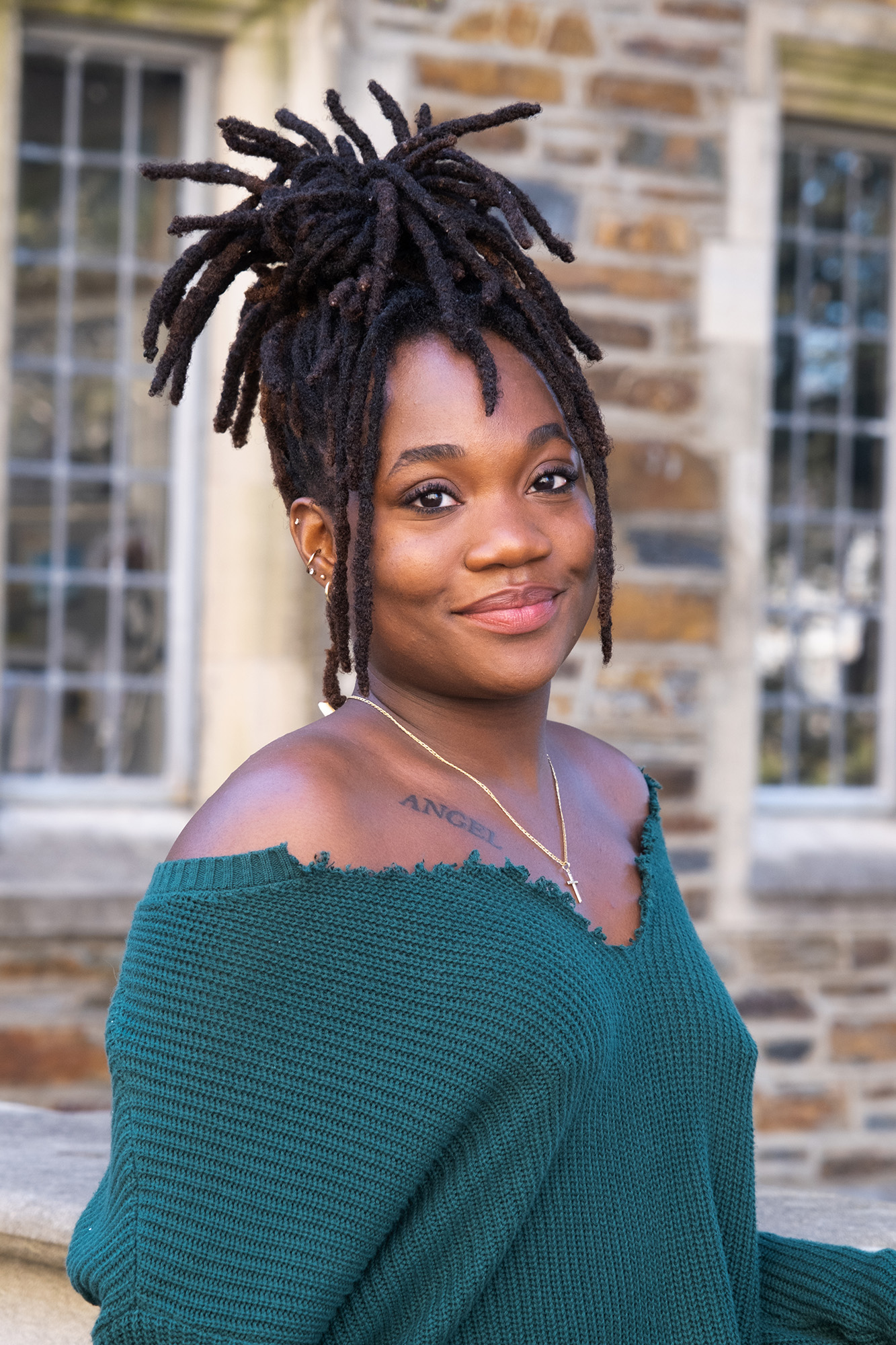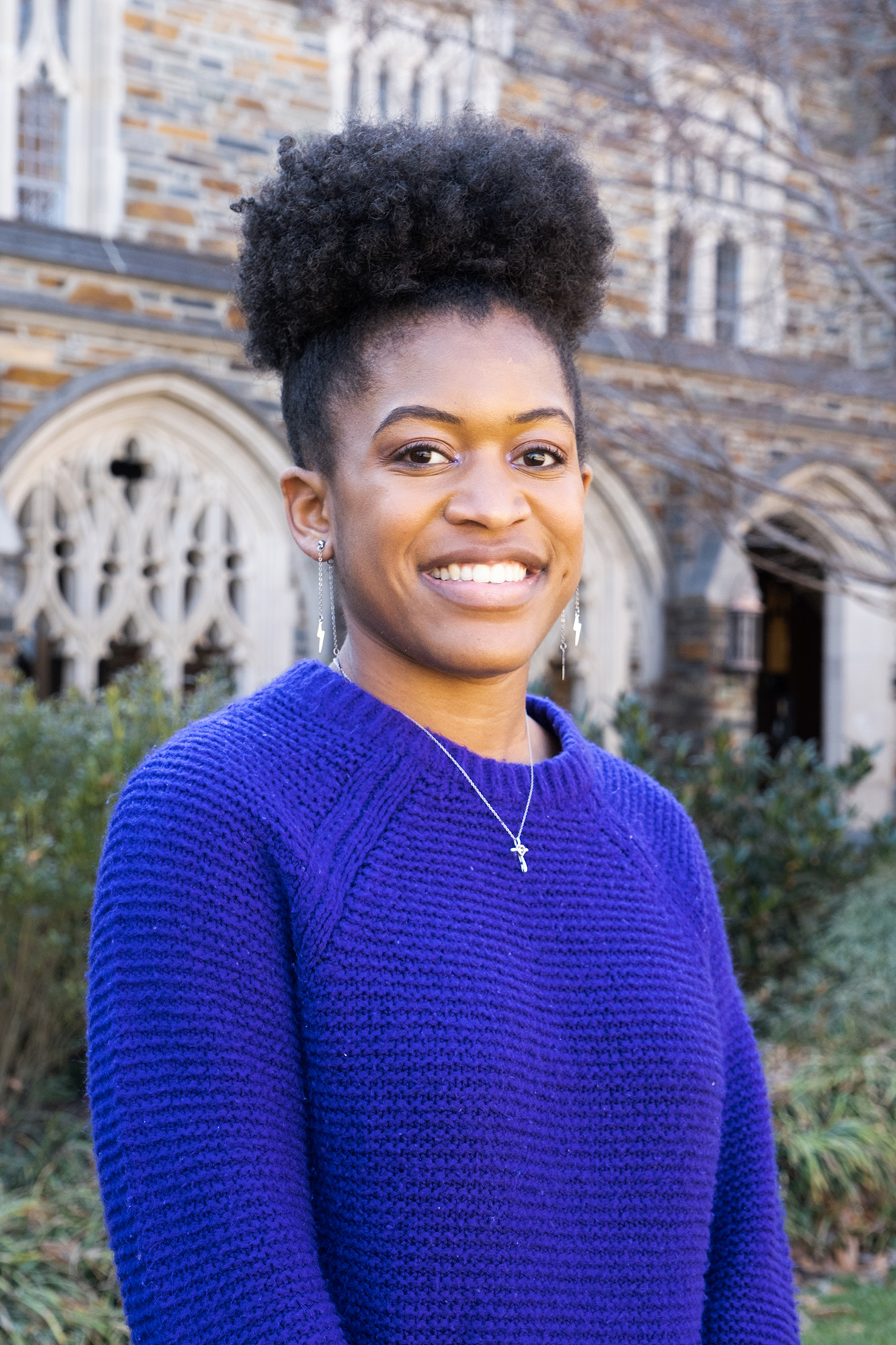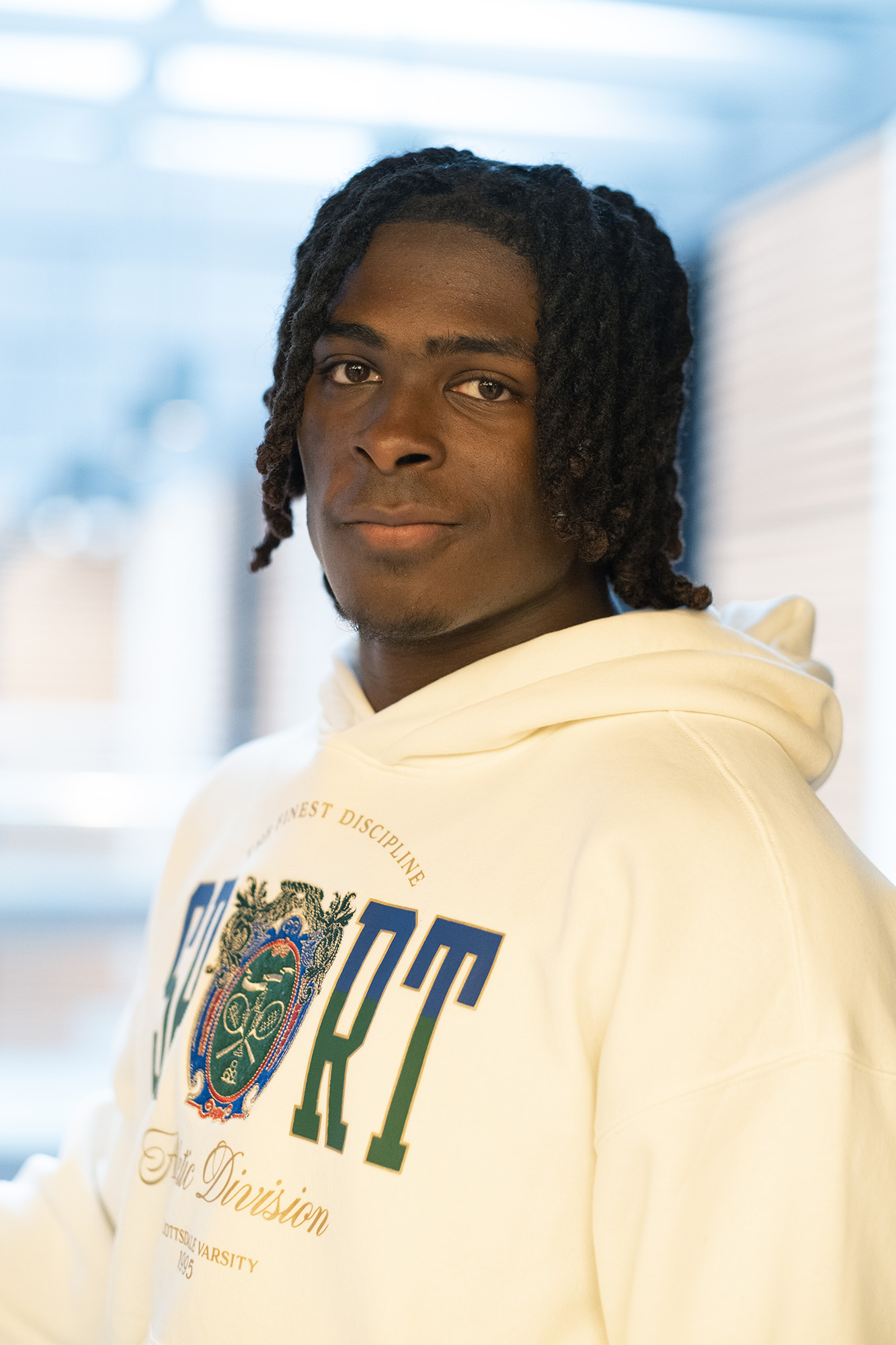Crowning Moment
Black hair and the movement to end discrimination

Ashleigh Shelby Rosette, a senior associate dean at the Fuqua School of Business, has studied societal bias against natural Black hairstyles. (Tyra Dixon)
“As a young woman, I’m constantly exposed to images of beauty, and from a young age, I learned that people with hair like mine are not always the first ones who come to mind when discussing what it means to be beautiful,” said Green, a sophomore.
For generations, people with Afro-textured hair have faced pressure to conform to a Eurocentric aesthetic that suggests straightened hair achieved with chemicals, heat, wigs or extensions, is more professional or attractive than natural Black hair worn loose and curly, or in styles such as afros, cornrows, braids or locs.
These perceptions may be shifting as segments of the Black community embrace the movement to wear natural hair. But research from two Duke professors, Jasmine Nichole Cobb and Ashleigh Shelby Rosette, highlights how biases against natural Black hair persist.
Their collective work elucidates some of the ways hair has been used as a mechanism for Black oppression dating back to slavery, and how it also may symbolize autonomy, pride and self-acceptance. Their work also calls attention to bias and discrimination against Black hair and the need for laws and policies, such as the CROWN Act and Duke’s own anti-discrimination policy, to protect against it.
FREDERICK DOUGLASS, INFLUENCER
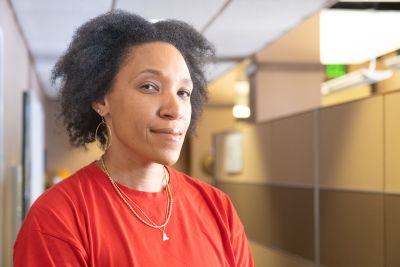
Jasmine Cobb, Duke professor and author of “New Growth: The Art and Texture of Black Hair.” (Tyra Dixon)
Fredrick Douglass was a courageous abolitionist and prominent essayist. As research from Cobb suggests, he also could have been the original social influencer for natural Black hair.
Douglass’s thick, wavy tresses and signature side part have fascinated people for two hundred years, says Cobb, author of “New Growth: The Art and Texture of Black Hair.”
The book focuses on Black hair in history, culture and art from slavery to the present. It explores the visual meaning of natural hair, whether to enslaved people in the 19th century or to artists in the 21st century, says Cobb, who is a professor of African and African American Studies and of Art, Art History and Visual Studies. Parts of the book examine the fascination with Douglass’s hair, and how changes over time symbolized his journey from enslavement to freedom.
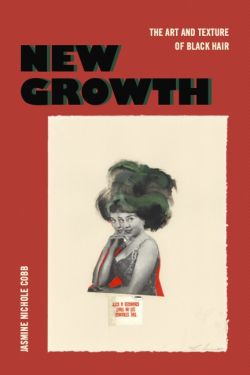
Like most enslaved people, Douglass was forced to keep his hair short, Cobb notes. After his escape from enslavement, photos show the evolution of his appearance. His hair becomes level with his cheekbones before eventually lengthening toward his chiseled chin.
The abolitionist knew his hair mattered to people, Cobb discovered by studying Douglass’s writings. At times, he brandished his hair texture, knowing it would convey his Blackness and earn credibility with some audiences, while strategically keeping others away.
“He tells a story of showing his hair when he’s asleep on a train to indicate he is Black, as a way of discouraging people to sit next to him,” Cobb says. “In another writing, he tells a story of traveling to England and keeping his hair long, so that the texture indicates his Blackness as a commodity on the abolitionist circuit. So it suggests a decisiveness about wielding the visibility of his hair.”
More than a century later, Douglass’s iconic hair still carries weight – so much so that Afro Sheen used his likeness in a 1970s commercial for natural hair care products.
“The producers of those commercials use his hair as a symbol for promoting not just hair products, but pride and racial progress,” Cobb says.
A HISTORY OF CONTROL
Black hair has also been a target throughout U.S. history.
“Hair has been a part of state-sanctioned violence against Black people,” Cobb says. “It has been part of interactions with police, interactions with persons of authority – all the way back to slavery, hair has been embroiled in a controlling of the Black body.”
In Virginia, law decreed how enslaved people could wear their hair, Cobb says. When enslaved people tried to escape but were captured, their heads would be forcibly shaved to signal to others that they were slaves just in case they ever tried to run away again, she says. Enslaved women who endured sexual violence at the hands of their enslavers were often threatened with forcible hair cutting if they didn’t comply, she notes in the book.
Long after slavery, Black hair continues to be targeted, particularly in confrontations with police and other authority figures, Cobb says. These events are so routine, Black students in the 1960s trained for nonviolent protests like sit-ins by enduring abuse including hair yanking and pulling, as shown in an unsettling historic photograph included in Cobb’s book.
Many wearers of locs or loc’d hair have also been targeted specifically because of their hair, Cobb notes. Locs historically have signified Rastafarian religious beliefs, which have been persecuted in Jamaica and in the U.S. in part due to spiritual traditions involving cannabis. Cobb’s book points to a particularly violent example in the 1978 arrest of activist Delbert Africa, whom police dragged by his locs from a Philadelphia home.
“In confrontations with police, wearers of locked hair have had locs yanked from their heads, or used to subdue them, to lay them down, or have faced more forcible cutting,” Cobb said.
Videos and photos of hair pulling in police encounters with Black citizens still proliferate in the news in 2023.
THE NEED FOR PROTECTION
From military grooming policies to school dress codes, to expectations for TV broadcasters and reporters, modern-day regulations that specifically affect Black hair abound.
While Cobb was researching her book, stories about how rules like these were harming children seemed to multiply: an 11-year-old boy suspended for wearing braids. A high-school wrestler’s locs cut by a referee, told the only alternative was to forfeit the match. Right in Durham at Hillside High School, student Nicole Pyles, pictured, also made national news when a softball official forced her to cut her braids off in the middle of a game, although she had played with the same hairstyle previously without issues.
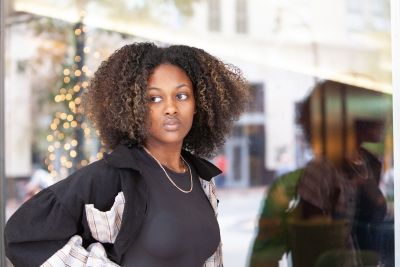
The public forcible cutting of children’s hair is ‘chilling,’ Cobb says, as it ties back directly to some of the tactics used to control enslaved people. In addition to having disturbing historical associations, dress codes for schoolchildren or workers that forbid natural styles have real implications on people’s economic and social mobility, she says.
“There are so many ways that Black people feel like they have to manage their comportment just to show up and do things that they’re capable of that have nothing to do with their hair,” Cobb says. “These things erode quality of life for people from a mental health standpoint as well as social advancement.”
Among the many reasons changing one’s Afro-textured hair can be a problematic, recent research suggests there are links between the use of lye-based hair relaxers and uterine and breast cancers.
These examples are among a long list of concerns raised by proponents of the CROWN Act, a national campaign founded in 2019 that has led to the passage of anti-discrimination laws in 20 states and dozens of municipalities, including the cities of Charlotte, Durham, Greensboro and Raleigh, and Orange County in North Carolina.
Duke’s anti-discrimination policy was revised in 2022 to specifically prohibit discrimination or harassment based on hair texture or hairstyles commonly associated with a particular race. The policy extends to temporary and contract employees, third parties within Duke programs and employees of Duke contractors.
“I think it’s a step towards saying it’s not just the individual wearer’s responsibility to wear their hair natural and tell people this is OK,” Cobb says. “A policy like this makes it a collective responsibility for all people to de-problematize textured hair.”
HAIR BIAS IN HIRING
These measures offer some protection. However, there are many ways perceptions about hair can negatively impact Black people that may be harder to regulate because they are due to bias – personal opinions that influence decisions, sometimes without the decision maker’s own awareness.
Research from Rosette, a senior associate dean at the Fuqua School of Business, has examined how biases about race and gender affect hiring and promotion in the workplace, including how societal bias against natural Black hairstyles infiltrates the workplace and perpetuates race discrimination.
In summer 2020, a journal published her research showing Black women with natural hair were perceived as less professional and less likely to get job interviews – findings that were cited by proponents of the CROWN Act and elicited countless references in the media, including a segment on Last Week Tonight with John Oliver.
Rosette and collaborators conducted several experiments. In one test, they recruited participants of different races and asked them to assume the role of recruiters screening job candidates.
Participants viewed profiles of Black and white female job candidates and asked to rate them on professionalism, competence and other factors. Black women with natural hairstyles received lower scores on professionalism and competence and were not recommended as frequently for interviews compared with three other types of candidates: Black women wearing straightened styles and white women with curly or straight hair, the researchers found.
Fictional job candidates faced discrimination specifically when they were being evaluated for roles in consulting, an industry with conservative dress norms. The researchers didn’t find the same effect when job candidates were evaluated for roles in advertising, which is viewed as a more creative industry that may allow more freedom in appearance.
“When a Black woman chooses to straighten her hair, it should be a personal preference, not a burden to conform to a set of criteria for which there could be adverse consequences,” she says.
When it comes to hiring, there are techniques to reduce the impact of bias, Rosette says.
“Some organizations strip away biographical information, such as a person’s name and other clues about gender or race, from application materials. This has been shown to reduce similar types of bias as what we found in our research,” Rosette says. “But there has to be a fundamental level of awareness that the natural hair bias exists in order to reduce its negative effects. If you don't know that it exists, you can’t know its influence on decision-making processes. Fortunately, there has been an increase in the adoption of policies by states, municipalities, and organizations to eradicate hair discrimination in organizations. We hope to see additional entities continue to implement these needed changes and perhaps even a federal law that prohibits hair discrimination.”
STUDENT STORIES
Black students from all over campus wanted to share stories about their hair, and the labor of managing perceptions about their hair in non-Black spaces, including interviews and jobs.
Eric Weatherly, an undergraduate from Florida, grew up in a predominantly white area and worked in a pizza shop as a teen. He remembers the owner, who was white, made a comment about Weatherly wearing his locs pulled back into a high ponytail.
“From that day on, I kind of stuck to wearing my hair down and not doing anything too crazy to draw attention to myself,” said Weatherly, whose locs reach his chin. Coming to Duke meant being surrounded by more Black students, many with natural hairstyles.
“Seeing fellow Black students with unique hair styles outside of mine – I just find it exciting that people are finally happy to show their culture off in public,” the sophomore says.
First-year student Ajani Adovor, who is studying computer science, says he has thought about whether he’ll have to ditch his short locs when it’s time to interview for internships or jobs.
“It’s something I have thought about a lot,” says Adovor, who was initially inspired to twist his hair into locs by the Black Panther character Killmonger. “In terms of being in a professional space, will my hair not be welcomed? I haven’t been in a space that has been super strict in terms of dress codes, so when it comes to my hair, I really don’t know what’s going to happen.”
Junior Jadyn Cleary says she gets a lot of questions from non-Black peers who are curious about her natural hair.
“It can be frustrating when I feel like I know so much about non-Afro-textured hair, and I realize that others know nothing about Afro-textured hair,” says Cleary, who is studying accessible digital design. Like many students, she says her hairstyles are often influenced by the people she’ll be interacting with that day.
“If I have an interview, that means trying to choose a style that I think will be more palatable, no matter the background of my interviewers,” she says.
Cleary and others said they are seeing increased representation of Black people with natural hair on television, social media and other channels, and they are hopeful this is a sign of changing perceptions about Black hair.

Aliaha Austin, graduate student, getting her hair styled by Durham salon owner and stylist Jey Hall (Tyra Dixon)
“This is a conversation that’s been happening for a long time,” says Green, a sophomore who is majoring in African and African-American Studies and Visual & Media Studies. “I think it’s starting to become more visible. There are a lot of people online sharing their hair journeys. When you turn on the TV now, you are seeing people on the red carpet with natural hair, or seeing it on shows.”
From Janelle Monae’s cornrows at the Oscars, to Associate Justice Ketanji Brown Jackson’s sisterlocks in the Supreme Court, these images mark cultural milestones.
“I think there’s a new appreciation for natural hair,” Cobb says. “When I think about all the time I’ve spent exploring this topic and what’s different, I now see people wearing and embracing natural hair and it’s not tied to product sales. What I think we’re seeing now is just the celebration and appreciation of textured hair, just for what it is visually and not so much what can be sold to people through their enjoyment of it.”
Senior Nasya Bernard-Lucien, a neuroscience major, says she fought her natural hair for the first two decades of her life because she had been exposed for years to mainstream media and what she calls a fixed definition of beauty – a thin nose, thin lips, and hair you can run your hands through.
“When I decided to try and relax my hair, I thought that it would finally be an escape from the difficulties and challenges that I thought my [hair] posed for me,” Bernard-Lucien says. “I soon came to realize that wearing my hair straight was not part of my story. Neither were sew-ins, wigs or braids. The decision to lock up my hair was a natural one, one that felt as though I finally found my authentic self.”
Embracing her hair in its most natural state has been an uplifting and self-affirming experience, Bernard-Lucien says: “There is weight in being able to live as your truest self and love who that is.”
